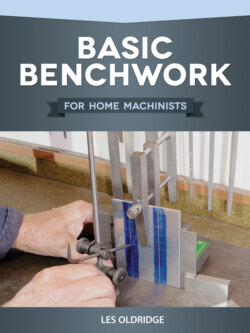Basic Benchwork for Home Machinists

Реклама. ООО «ЛитРес», ИНН: 7719571260.
Оглавление
Les Oldridge. Basic Benchwork for Home Machinists
BASIC BENCHWORK FOR HOME MACHINISTS
Contents
Chapter 1. Introduction
Chapter 2. Materials
MATERIALS
Chapter 3. Reading Engineering Drawings
Chapter 4. Hacksaws
Chapter 5. Files and Filing
USE OF FILES
Chapter 6. Hammers, Chisels, and Punches. HAMMER
CHISELS
PUNCHES
Chapter 7. Scrapers and Scraping
Chapter 8. Measuring
CALIPERS AND DIVIDERS
Chapter 9. Marking Out
Chapter 10. Drills and Reamers
Chapter 11. Screwed Fastenings, Spanners, Screwdrivers, and Pliers
SCREW THREAD NOMENCLATURE
SCREW THREAD SYSTEMS
SPANNERS
SCREWDRIVERS
PLIERS
Chapter 12. Taps and Dies
Chapter 13. Riveting
Chapter 14. Soft Soldering
Chapter 15. Silver Soldering, Brazing, Bronze Welding, and Engineering Adhesives
Chapter 16. Welding
OXY-ACETYLENE WELDING
ARC WELDING
INERT GAS SHIELDED WELDING
Chapter 17. Hardening and Tempering Tools
TEMPERING
CASE HARDENING
Chapter 18. Keys, Keyways, Splines, Collars, and Shafts
Chapter 19. Sheet Metalwork
Appendix
Acknowledgments
Отрывок из книги
BASIC BENCHWORK FOR HOME MACHINISTS
Chapter 2 Materials
.....
The North American naming convention uses a four digit number that helps to identify the steel type and its carbon content. Common steel types used by hobbyists include 1018, a common, low carbon steel, and 12L14, a low carbon steel with lead added to improve its machinability.
PLAIN CARBON STEELS. The main difference between cast iron and steel is the carbon content. Plain carbon steel has never more than 1.5% carbon, whereas cast iron, as has been stated above, has about 3%.
.....